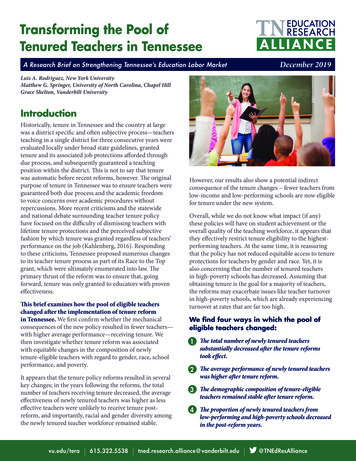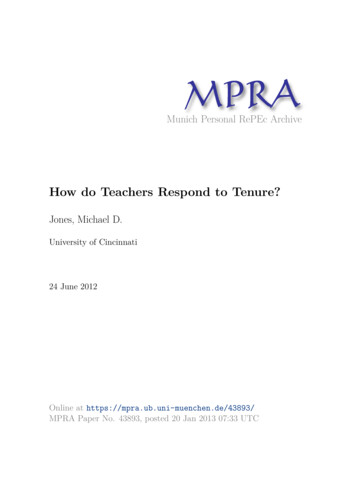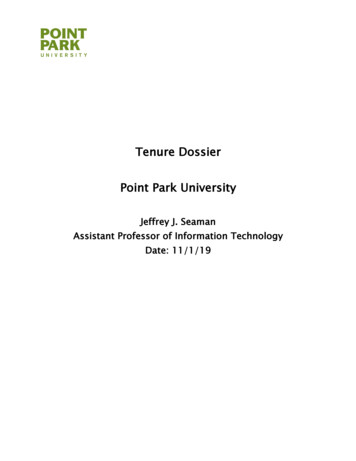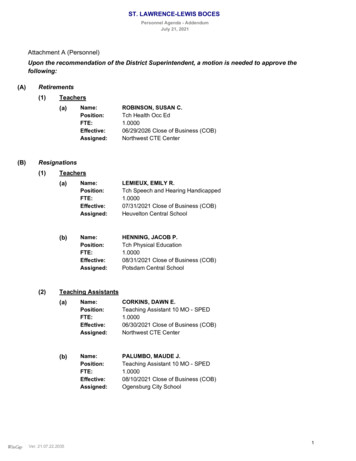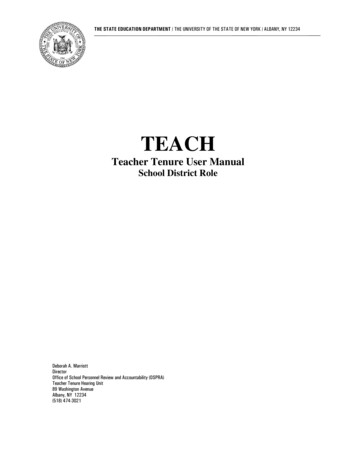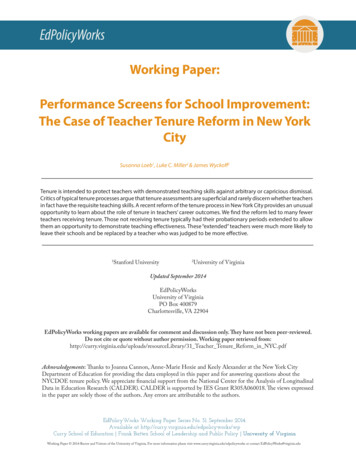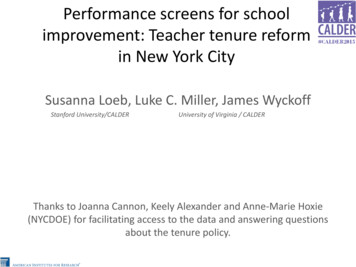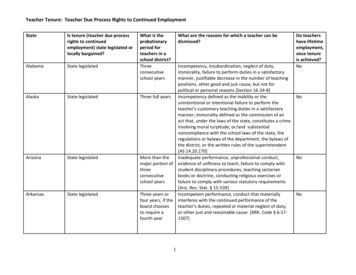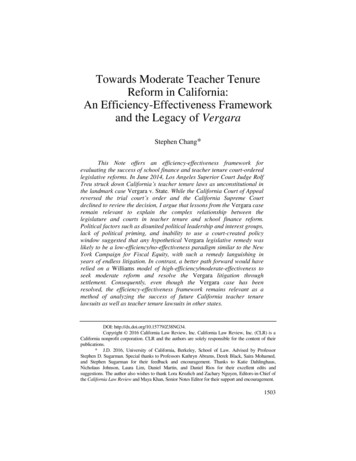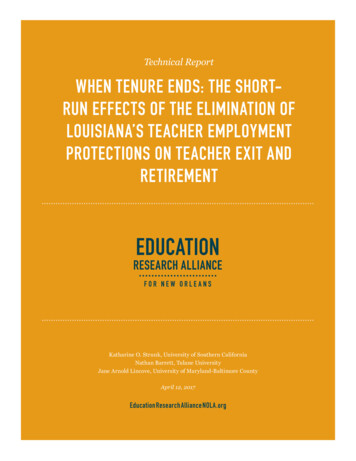
Transcription
Technical ReportWHEN TENURE ENDS: THE SHORTRUN EFFECTS OF THE ELIMINATION OFLOUISIANA’S TEACHER EMPLOYMENTPROTECTIONS ON TEACHER EXIT ANDRETIREMENTKatharine O. Strunk, University of Southern CaliforniaNathan Barrett, Tulane UniversityJane Arnold Lincove, University of Maryland-Baltimore CountyApril 12, 2017EducationResearchAllianceNOLA.org
When Tenure Ends: The Short-run Effects of the Elimination of Louisiana’s TeacherEmployment Protections on Teacher Exit and RetirementApril 11, 2017Katharine O. Strunka, Nathan Barrettb, Jane Arnold LincovecThe research presented here utilizes confidential data housed at the Education Research Alliance for New Orleans. Wegratefully acknowledge the receipt of these data and funding for this study from the Laura and John Arnold Foundation.We wish to thank Josh Cowen, Doug Harris, Andrew McEachin and seminar participants at the Stanford Center forEducation Policy Analysis and at Michigan State University for their insights. The views expressed in this paper do notnecessarily reflect those of ERA-New Orleans, the University of Southern California, Tulane University, the Universityof Maryland-Baltimore County or the study’s sponsors. Responsibility for any and all errors rests solely with the authors.Corresponding author. University of Southern California, 3470 Trousdale Parkway, Los Angeles, CA 90089, USA.Email: kstrunk@usc.edu, (213) 740-2190 (o).aEducation Research Alliance of New Orleans, Tulane University, 1555 Poydras Street, 7th Floor, Room # 701, NewOrleans, LA 70112. Email: nbarret@tulane.edu, (504) 274-3617 (o)bcUniversity of Maryland, Baltimore County. School of Public Policy. Email: jlincove@umbc.edu, (512) 779-2045 (o)1
I.INTRODUCTIONThe large majority of public school teachers, like other public employees, have long-standing employment protections that shield them from arbitrary or capricious dismissal. At thecenterpiece of K-12 public school teacher protections are tenure policies, which intentionally erectbarriers to dismissing teachers by setting guidelines around the length of time teachers serve in“probationary” positions, after which they only can be dismissed for “just cause.” Administratorswishing to dismiss a tenured teacher must provide notice, issue a statement of causes fortermination, conduct a hearing, and provide the right for appeal (Christie & Zinth, 2011).Proponents of public school teacher tenure argue that these laws are necessary to protectteachers from unreasonable job requirements, censure, and arbitrary dismissals. Further, tenureprotection might improve teacher recruitment and retention if teachers are willing to accept lowersalaries in return for enhanced job security, relative to opportunities in other industries(Chermerinsky, 2014; Public Impact, 2011; Ravitch, 2015; Rothstein, 2015). Opponents of tenureprotections argue, on the other hand, that tenure harms schools and students by making it nearlyimpossible to fire ineffective teachers due to the time and resources required to meet due processobligations (e.g., Hanushek, 2015).The debate over teacher tenure has been elevated in the media and public discourse throughhigh-profile cases like Vergara vs. California and Wright vs. New York, in which plaintiffs argued thatstate tenure laws enable ineffective teachers to teach in public school classrooms, and in particular inthe classrooms of low-income and minority students. Many state legislatures have attempted withincreasing success to implement reforms to teacher tenure. Prior to 2009, no state’s tenurelegislation required districts to take performance into account in making tenure decisions. By 2016,16 states mandated that tenure could not be granted without evidence of teaching effectiveness, andseven states have enacted laws that allow districts to rescind tenure protections from already tenured2
teachers if they don’t meet performance standards. Three states have passed laws that effectivelyeliminate tenure and/or due process rights for teachers (NCTQ, 2016; Thomsen, 2016).The logic behind policy reforms that shift to employment-at-will or make tenure-basedemployment security dependent on teacher performance, and thus harder to attain, is that theyshould provide administrators more flexibility to remove ineffective teachers and thus improve thequality of the teaching workforce. However, this theory of action may ignore important benefits oftenure and the potential negative consequences that tenure reform may have on the teacher labormarket. Research suggests that public school teachers implicitly value job security, and that theremoval of job protections will negatively affect teacher recruitment and retention. In particular,tenure may be viewed by teachers as a part of their overall compensation package, and teachers maybe willing to accept difficult working conditions and relatively low pay only when tenure protectionsprovide substantial job security (e.g., Feinberg, 1981; Brunner & Imazeki, 2010; Rothstein, 2015).Therefore, a potential unintended consequence of removing tenure or tying tenure to teacherperformance is increased teacher attrition. Ideally, those who exit as a result of the removal of tenureprotections would be the lowest job performers who are either counseled out of the workforce orwho choose to leave based on information that they may be at risk of job loss. However, even ifsome or most of the exiting teachers are lower-performing, their sudden absence requires planningand resources to recruit replacements of adequate quality, possibly resulting in declines in the overallquality of the teacher labor force. However, little research attention has been paid to the impacts oftenure reforms on the teacher workforce, leaving policymakers with inadequate information aboutthe potential effects of reform on which to base policy decisions.In this study, we measure the effects of the elimination of teacher tenure in Louisiana onteacher attrition. Louisiana is a particularly apt location for study. In 2012, Louisiana effectivelyeliminated teacher tenure, replacing the lifetime teaching credential (previously earned after three3
years on the job) with a temporary license dependent on positive performance appraisal. As we willdiscuss below, Louisiana was also in the process of developing a statewide teacher evaluation system,known as Compass, which was to be used in part to inform teachers’ employment. However, for thefirst two years of tenure reform, there were no evaluation data available to inform dismissaldecisions, leaving teachers in this period to react to the removal of tenure without thecomplementary threat of information provided by high-stakes evaluations. Using an eight-year panelof teacher-level administrative data, we employ an interrupted time series (ITS) model to examinechanges in patterns of teacher attrition in the two years after the removal of tenure. We then attemptto isolate the causal impact of tenure removal by using comparative interrupted time series (CITS)analyses and identifying two sets of comparison groups that should be similarly affected by otherconditions but differentially affected by the removal of tenure: 1) third-year teachers who neverreceived tenure versus fourth-year teachers who lost tenure due to the reform; and 2) fullyretirement eligible teachers who had alternative pension-funded options versus partially-eligible orineligible teachers We also compare traditional public school teachers with charter school teachers,who were always at-will employees and did not benefit from the tenure law before its removal. Last,we examine if there was differential reform-induced attrition for teachers in schools that serve moretraditionally disadvantaged student populations. We conduct several falsification tests to confirm ourresults, including specifications that isolate the passage of the tenure reform from the onset of theCompass evaluation system. Thus we come as close as possible to estimating the causal effects ofthe tenure policy change alone (and not teacher evaluation or other contextual variables) on shortterm teacher exit.This work is the first to utilize a state-wide administrative dataset to assess the impact of theremoval of tenure protections on teacher exits from the state, enabling us to provide the firstevidence that the removal of tenure protections causes a substantial increase in teacher attrition. We4
find that 8.7 percent of teachers exited teaching in the year of tenure removal, a 20 percent (1.4percentage points) increase from the year prior to the reform. Exits are concentrated amongteachers who either derive a greater benefit from tenure (4th year teachers and traditional publicschool teachers) or have a more certain alternative income through retirement. We find no evidenceof effects on teachers who should not be affected by the tenure reform, including charter schoolteachers, and no differential effects across groups of teachers who face similar benefits from tenureprotections. However, we do find evidence that teachers in Louisiana’s lowest-performing (“F”rated) schools are more likely to exit teaching as a result of the tenure reforms. ITS analyses confirmthat, while there was a small increase in attrition at the onset of the Compass evaluation system, thetenure reform itself substantially escalated teacher exit rates net of any evaluation system effect. Allof this raises confidence that the removal of tenure protections caused a significant increase inteacher attrition in both the year immediately after the reform and the following year. Estimatessuggest that reform-induced attrition was equivalent to losing between 1,500 to 1,700 teachers in thefirst two years after the removal of tenure protections, or 3.0 to 3.5 percent of Louisiana’s teacherworkforce.In what follows, we first review Louisiana’s education reform context. In Section III, wereview the limited research base that currently informs the debate surrounding tenure reforms.Section IV describes our dataset, including descriptive statistics on Louisiana teachers and their exitrates over time, and details our empirical strategies. Section V reports results from our analyses.Section VI concludes with a discussion of our results and their implications for other statesconsidering teacher policy reform.II. TEACHER TENURE AND POLICY REFORM IN LOUISIANABetween 2010 and 2015, the Louisiana legislature enacted multiple teacher policy reforms,including major legislation affecting teacher evaluation (Act 54) and teacher tenure (Act 1). Figure 15
displays the timeline of the implementation of these reforms. Act 54 was passed in 2010 andrequired the Louisiana Department of Education (LDOE) to develop a statewide multiple-measureteacher evaluation system.1 This system, known as Compass, was developed in 2010-11 and pilotedin a small number of districts during 2011-12 school year. Evaluations for all teachers statewide wereconducted for the first time in 2012-13, with results available to school districts and principals in thefall of the 2013-14 school year.Compass would provide new information on teacher performance, but Louisiana’s existingtenure protections restricted a district’s ability to use performance data in dismissal decisions. Priorto 2012, Louisiana’s tenure law looked similar to those in place in most states (NCTQ, 2016). 2Teachers served a probationary period of three years during which a teacher could be dismissedupon recommendation of the superintendent for “valid reasons.”3 After the third year, dismissalrequired a hearing by the local school board at which the teacher was found guilty of “willful neglectof duty, incompetency, dishonesty, immorality, or being a member of a group that was legallyprohibited from operating in the state” (Act 1, Louisiana H.B No. 974, 2012).Act 1 (the “Talent Statute”), passed in July 2012, created new rules for dismissal, capitalizingon the teacher performance data that would be available via the Compass evaluation system. Act 1designated local superintendents and principals as the final authority in personnel decisions,emphasizing that personnel policies and decisions should be based on teacher performance.Although the word “tenure” is still used, the definition is quite different. First, Act 1 extended thetime to tenure and made the status contingent on performance. For untenured teachers as of thebeginning of the 2012-2013 school year, tenure would be granted only after a teacher received ahighly-effective Compass rating for five out of six consecutive years, a stipulation that makes itnearly impossible to gain tenure.4 Second, Act 1 changed the definition of tenure for all teachersregardless of prior tenure status. Specifically, tenure is immediately revoked if a teacher is rated6
ineffective on Compass. A teacher without tenure can be dismissed for a “valid reason” by aprincipal or superintendent at any time. For these teachers, as well, tenure can be regained only byreceiving a highly-effective Compass rating for five of six consecutive years. But since tenure isrevoked any time a teacher is ranked ineffective, there is no status that fully protects a teacher frompotential dismissal. In other words, the common definition of teacher tenure as a nearly guaranteedjob for the remainder of a teacher’s employment in a district no longer applies for any Louisianapublic school teacher.5 From the teacher’s perspective, then, Act 1 profoundly reduced job security,making teaching a higher risk occupation than it had been prior to 2012 by basing job protectionsand compensation on evaluated performance rather than experience and seniority.Because both evaluation and tenure reforms were instituted in a relatively condensed timeperiod in Louisiana, it could be hard to disaggregate the impact of the removal of tenure protectionson teacher attrition from the effect of high-stakes teacher evaluation. The implementation timelineof these policies, however, provides us with the ability to isolate the effect of tenure reform. Therewas a two-year gap between the implementation of the tenure reform at the end of the 2011-12school year and the availability of the first Compass evaluation data for decision making in the fall ofthe 2013-14 school year. This means that during the 2012-13 and 2013-14 school years, teachers nolonger retained traditional tenure protections, but their exit decisions could not have been motivatedby information from Compass. That being said, given that the far majority of states that haveimplemented tenure reforms have done so in conjunction with new high-stakes teacher evaluationsystems, the policy reform of interest might also be conceived of as the combination of the removal ofemployment protections resulting from increased teacher-level accountability tied to tenure reforms.In this case, the corresponding Louisiana policy would be the implementation of Act 1, which tiedhigh-stakes consequences to the new multiple measure teacher evaluation system.6Figure 1 illustrates the timeline for passage and implementation of the two policies. Act 547
ordered the creation of Compass in spring 2010, and Compass was designed during the 2010-2011school year and piloted during the 2011-2012 school year. Although teachers were initially evaluatedusing the new Compass system in 2012-13, the results of these evaluations were not issued until fall2013. If we assume that teachers primarily exit in the summer, teacher exits due to anticipation ofpoor Compass evaluations could have begun as early as the summer of 2010 as teachers reacted tothe expectation of high stakes evaluations (which we test for below). However, any exits attributableto actual consequences of Compass would have been delayed until summer 2014.Act 1 was passed in the spring of 2012, and the tenure reform went into effect right away inthe summer of 2012. Teachers worked without traditional tenure protections during the 2012-13 and2013-14 school years, meaning that we might see evidence of tenure reform-induced attrition in ourdata in those years, before exits resulting from receipt of Compass evaluation scores could havebegun. Such exits were unlikely to be driven by principals’ removal of underperforming teachers, asduring this time they still did not have Compass information about teacher quality. In other words,changes in the rate of teacher exit prior to summer 2014 likely result as a voluntary response byteachers to the loss of employment protections. If teachers exited in response to the passage of theteacher evaluation law, that exit would have commenced in summer in 2010. If teachers exited inresponse to the pure loss of tenure protections, causing employment to be tied to measures ofperformance, that exit would have commenced in summer 2012 and continued in summer 2013. Inthis study, we examine exit trends from the summer of 2006 to 2013 to estimate the effect of thisdecrease in job security on the teacher workforce in Louisiana. 7III. TEACHER TENURE, EMPLOYMENT RISK AND THE TEACHER LABORMARKETThe removal of tenure protections for teachers has been debated both in the courts and statelegislatures. Proponents of job protections for teachers argue that tenure is necessary both to attractqualified new teachers to the profession and to retain teachers in public schools (e.g., Chermerinsky,8
2014; Ravitch, 2015; Rothstein, 2015). The rationale these scholars and public figures employ in theirdefense of tenure in part relies on the fact that teachers value tenure – or any employmentprotections – as a key component of their overall compensation. This may well be the case; extantresearch illustrates that teachers consider both monetary and non-monetary benefits from theirpositions in their calculation of total compensation (e.g., Loeb & Page, 2000). Non-pecuniary factorsthat teachers value include employment characteristics such as working conditions, school climate,and student endowments (e.g., Antos & Rosen, 1975; Kenny & Denslow, 1980; Chambers, 1981;Levinson, 1988; Horng, 2009). More importantly for this study, teachers, like other workers, alsovalue job stability and the absence of employment risk, or certainty about their likelihood ofretention (e.g., Authors, 2016a; Feinberg, 1981; Murnane & Olsen, 1990; Rothstein, 2015).Absent tenure protections, there is a greater degree of risk involved in teaching. Teachersface a risk of dismissal due to factors both within and beyond their control, which introducesuncertainty into teachers’ assessments of future compensation. Because teachers value job security(the absence of risk) as part of their total compensation package, the removal of tenure effectivelydiminishes their overall compensation. As a result, a risk-averse teacher with a positive risk ofdismissal will accept an alternative position that a teacher with zero probability of dismissal (or arisk-neutral teacher) would not accept. Therefore, to the extent that such job opportunities exist, theteacher without job security is more likely to exit in any given year.Although there is a great deal of public discourse about the benefits and drawbacks of tenureprotections, there is little research that tells us how tenure policies influence the workforce throughindividual decisions to enter or exit the profession. This is due in large part to the fact that tenurepolicies have existed for over a century in the United States, but only recently have policy changesenabled rigorous evaluation of their impacts. In the absence of sufficient policy variation in teachertenure, two recent studies have utilized simulations to test the labor market impacts of diminished9
tenure protections (Staiger & Rockoff, 2010; Rothstein, 2015). Both suggest that productivitybenefits could be accrued by lessening tenure protections, either by delaying the provision of tenureand/or decreasing the fraction of teachers who are awarded tenure. However, Rothstein (2015), whomodels teachers’ behavioral responses to the diminution of tenure protections, finds that morerigorous tenure processes would necessitate substantial salary increases in order attract new teachersto a high-risk employment environment (Rothstein, 2015). Specifically, Rothstein (2015) examinesthe implementation of alternative tenure processes (denying more teachers tenure and lengtheningthe time before the tenure decision) in a simulated labor market. He shows that denying tenure tomore teachers (56-57%) and potentially pushing the tenure decision out an extra year would requirea 30 to 33% increase in average teacher compensation.Some empirical evidence also supports the notion that teachers view tenure as a part of theirtotal compensation. For instance, Brunner and Imazeki (2010) illustrate that beginning teachersalaries are positively associated with the length of time to tenure; in states with longer probationaryperiods, districts must pay beginning teachers higher salaries to compensate for the increased riskassociated with teaching without tenure. Similarly, in the only study of which we know that examinesa tenure policy change, Loeb, Miller and Wyckoff (2015) show that, under a policy in New York Citythat extended the pre-tenure probationary period for a subset of less effective teachers, teachers whohad their probationary time period extended were significantly more likely to voluntarily exitteaching in New York City public schools than were teachers who were granted tenure.8To date, we know of no published research that empirically examines the impact of a state’stenure reform on teacher attrition. Empirical studies of the elimination of similar employmentprotections in other sectors of government suggest that reforms that remove job protections alteremployer-manager relations and perceptions (Battaglio, 2010; Battaglio & French, 2016) and mightnegatively influence recruitment (Bowman & West, 2006). Our study provides a new source of10
evidence to help inform policymakers and researchers about the effects of tenure reform on teacherattrition.IV. DATA AND EMPIRICAL STRATEGYDataWe use an eight-year panel of teacher- and school-level data, spanning the 2005-06 through2012-13 school years. Our full analytic dataset consists of 406,782 teacher–year observations from76,629 teachers and 1,643 schools. Data were provided by the Louisiana Department of Education(LDOE) and include elements from the state’s Profile of Educational Personnel (PEP) and StudentInformation System (SIS) datasets. PEP includes de-identified teacher observations for all traditionalpublic school (TPS) and charter school teachers in Louisiana. Variables include demographics,teaching certificates, college degrees, whether or not a teacher graduated from a Louisiana college,whether or not a teacher ever held a probationary certificate (a proxy for entering the professionthrough an alternative pathway), school assignments, and district hire dates. We can observe teachersas they move across public schools in the state, and we identify teacher exit through departure fromthe PEP dataset. If a teacher does not appear in the data the following year, he is coded as exitingduring the summer. Thus, with data through the 2013-14 school year, we are able to observe exitsspanning the summers of 2006 through 2013.9As will become clear in our discussion of our methods, accurately identifying teacherexperience is particularly critical to our analysis. Unfortunately, the PEP data do not include anexplicit measure of experience, so we generate this measure using a combination of reported salaryinformation and district hire dates. In most cases we rely on salary data to determine teacherexperience level because teacher salaries are dictated by teaching experience and education levels,and are codified in the published negotiated teacher salary schedules available for each district. UsingPEP data on teacher salary and education levels, we are able to identify a teacher’s experience level11
by working backwards from the district’s reported salary schedule. Salary data are available for 92%of teachers in our sample. We then used district hire date to confirm experience derived from thesalary schedules and to impute experience for remaining teachers. Hire dates report the first time ateacher worked for a school district but not necessarily as a teacher. Estimating experience based onhire date involves first measuring the time between the hire date and the initial observation of ateacher in our dataset. We then add one year for each additional year of teaching observed in thePEP data.10 Hire date is available for 88 percent of all teachers, but because hire dates areunderreported prior to 2010-11, missing values are concentrated among more experienced teachers.Our final experience measure is based on derived experience from the salary data. We usethis measure for the 80% of teachers who have both salary and hire date-derived experiencemeasures11 and for the 12% of teachers who are missing their hire date but for whom we cangenerate a salary-based measure. Seven percent of teachers had a valid post-2011 initial hire date, butwe could not confirm experience through a published salary schedule, and we use the hire-datemeasure of experience for these teachers. (Almost all of these cases were teachers at charter schools,which do not publish salary schedules.)12 The remaining teachers, only 1.3 percent of the sample, areexcluded due to missing values across both measures of experience. We provide summary statisticsof teacher experience and all other teacher-level covariates by analytic group in Table 1.We also include school-level measures in our analyses to control for school conditions thatchange over time and might influence a teacher’s propensity to exit. We generate these measures byaggregating student-level SIS data that describe student demographics and educational needs(race/ethnicity, English proficiency, special education status, and free/reduced price luncheligibility). We also include state-reported school performance scores (SPS), which aggregate studentproficiency on state standardized tests and are used to determine the school’s accountability status.SPS calculations change across the time period under study, so SPS scores in this study are12
normalized within year and school level.13 In some of our analyses, we separately examine the impactof the tenure reform on schools with high or low proportions of historically disadvantaged students,defined as those in the top or bottom quartile of schools by proportion minority, low-income(qualify for free- or reduced-price lunches), and with low or high SPS levels and SPS growth. Wealso examine schools with high or low performance on the state’s A-F accountability system. Finally,we also identify all charter schools and use charter school teachers as a comparison to TPS teachers.Louisiana charter school teachers are employed by private charter management organizations. Theywere not covered by the Louisiana tenure law prior to 2012, and therefore their employmentprotections were not affected by the tenure reform.14 Charter school teachers were covered by theteacher evaluation policy and received Compass evaluations beginning in fall 2013 similar to TPSteachers. Charter schools are located primarily in New Orleans and most opened after hurricaneKatrina in 2005, so any analysis using charter school teachers begins in 2006-07 instead of 2005-06.15Empirical StrategiesFirst, we use an interrupted time series (ITS) model to estimate teacher exit before and afterthe Louisiana tenure reform, controlling for teacher and school characteristics. Second, we usecomparative interrupted time series (CITS) models to test for differential exit propensities over timefor teachers who should be more affected by the loss of tenure. We compare teacher exit before andafter the tenure reform. The timing of the policy implementation is very important to our estimationstrategies, because of the timeline described in Figure 1. If the concept of performance-basedevaluation caused teachers to perceive teaching as a riskier (or simply less friendly) occupation, anyresulting exit would have commenced during the summer of 2010, when Act 54 was passed. Teacherexits in response to the tenure policy change (Act 1) itself would likely have begun in the summer of2012, and response to actual evaluation data coupled with tenure reform would be delayed untilsummer of 2014. Given the staged implementation of Compass, Louisiana’s outcomes in 2011-1213
and 2012-13 offer the best opportunity to isolate the effects of the removal of tenure on the teacherworkforce as a whole through the labor market choices of teachers. Throughout our analysis, weidentify a teacher as an exiter in a specific school year if she did not return to teaching the followingfall (e.g. a teacher “exits” in 2011-12 if she does not return to teaching in 2012-13). Thus, we identify2010-11 as the final baseline pre-tenure reform year, 2011-12 as the first post-tenure reform year,and 2012-13 as the second post-tenure reform year. All years are identified by the spring of theacademic year in our tables so that, for example, 2010-11 will be labeled 2011.Interrupted Time Series ModelsWe begin with a descriptive estimation of changes in the probability of teacher exit aftertenure reform. At the teacher level, we first estimate an ITS model of the probability that a teacherexits for a period of time from summer 2006 (exits after the 2005-06 school year) to summer 2013(exits after the 2012-13 school year). We employ the model recommended by Somers, Zhu, Jacob,and Bloom (2013) for ITS models with two years of post-intervention data, as follows:𝐸𝑋𝐼𝑇!"# 𝛼! 𝛿! 𝑌𝐸𝐴𝑅! 𝛼! 2012! 𝛼! 2013! 𝑋!" 𝑍!" 𝜑! 𝜇! 𝜀!" [1]where EXITijt is equal to one if a teacher i in school j exits teaching in year t. EXITijt is equal tozero if the teacher returns to any public school teaching position in Louisiana. 16 We run al
The debate over teacher tenure has been elevated in the media and public discourse through high-profile cases like Vergara vs. California and Wright vs. New York, in which plaintiffs argued that state tenure laws enable ineffective teachers to teach in public school classrooms, and in particular in the classrooms of low-income and minority .
